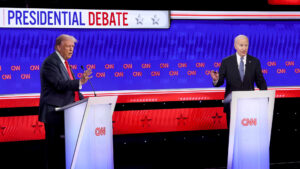Welcome to Extreme Investor Network, where we go beyond the headlines to provide you with insightful analysis and expert commentary on all things finance. Today, we’re delving into the topic of inflation and the recent trends that have been observed in the market.
Inflation decelerated again in June, bringing further relief to consumers’ wallets. The consumer price index rose 3% in June 2024 from June 2023, down from a 3.3% annual inflation rate in May, according to the Bureau of Labor Statistics. While inflation isn’t quite back to policymakers’ long-term target around 2%, it has significantly cooled from about 9% two years ago, the highest level since 1981.
But why did inflation initially take off? This question was at the center of a recent U.S. presidential debate, where both candidates, President Joe Biden and former President Donald Trump, traded blame for the inflation-related grievances during the pandemic era. However, economists point out that the cause of inflation is not as straightforward as it may seem.
According to experts, global events beyond the control of Trump or Biden wreaked havoc on supply and demand dynamics in the U.S. economy, fueling higher prices. Factors such as slow action by the Federal Reserve to contain hot inflation, pandemic relief packages, and so-called “greedflation” all played a role in the inflationary pressures observed in recent years.
Economists emphasize that the presidents deserve neither full credit nor full blame for the economy’s performance. In fact, they stress that the pandemic and the Russian war in Ukraine were significant factors contributing to the inflationary environment seen in recent years.
Looking deeper, the pandemic disrupted global supply chains and led to labor shortages, while consumers shifted their spending patterns, further exacerbating the mismatch between supply and demand. Additionally, events such as automakers’ semiconductor chip shortages and disruptions caused by Russia’s war in Ukraine all contributed to the spike in inflation.
The role of big spending bills, such as the American Rescue Plan signed by Biden in 2021, also came under scrutiny. While these measures provided relief to households, they also pumped more money into the economy, fueling demand and contributing to inflation.
Furthermore, the Fed’s actions also played a role, with economists pointing out that the central bank was slow to raise interest rates and throttle back on quantitative easing, fueling inflationary pressures. The concept of “greedflation,” where corporations take advantage of the high-inflation environment to boost profits, may have also played a minor role in inflating prices.
In conclusion, while Biden and Trump may have played a part in the inflationary environment, it is essential to understand the broader global and economic factors that have influenced the market dynamics. Stay tuned to Extreme Investor Network for more in-depth analysis and expert insights on the ever-evolving world of finance.

